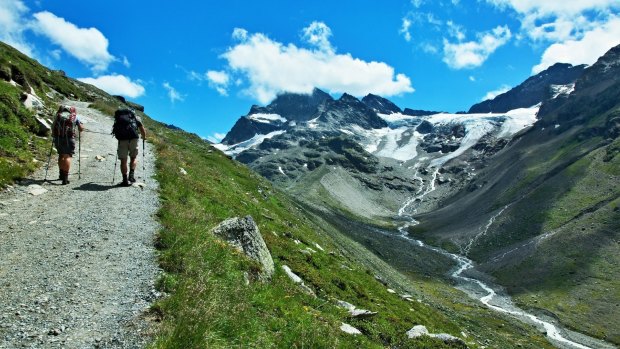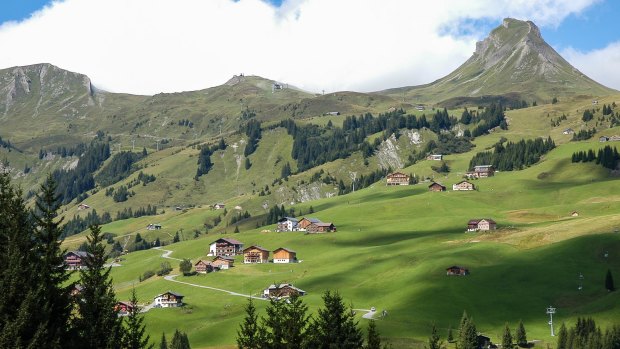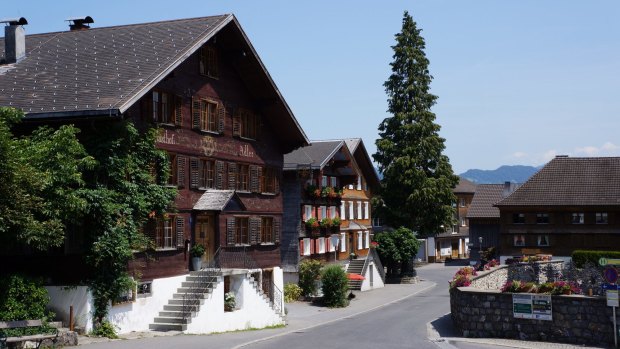This was published 6 years ago
Bregenzerwald region, Vorarlberg, Austria travel guide: Like stepping back in time
By Craig Platt

Piz Buin mountain in Vorarlberg, Austria.Credit: Shutterstock
It's perhaps not surprising that the Austrians of the country's westernmost state, Vorarlberg, have two common questions for visitors who have come from a far-off country.
The first is: "Have you been to Austria before?"
The second is: "Vienna and Salzburg?"

A village in the Bregenzerwald, Austria.Credit: Shutterstock
And I answer "yes" to both these questions. It's actually my third visit to the European country renowned as a centre of music, art and high standards of living. But this is the first time I've gone outside Austria's two most famous cities.
This part of the country, bordering Switzerland, Germany and Liechtenstein, is a popular holiday spot for Austrians and Swiss, but it remains relatively unknown to Australians.
Perhaps its biggest claim to international fame is the role its geography played in the origins of an invention that is dear to the heart of every Australian: sunscreen.

Gasthof Hirschen in Schwarzenberg. The buildings of the region look as if they could have been assembled from a model kit.Credit: Shutterstock
In 1938, Swiss chemist Franz Greiter decided to hike Piz Buin, a peak in the south of the state.
In the sunny weather and at high altitude, Greiter found himself badly burnt by the sun. Annoyed, and no doubt in considerable pain, he decided to do something about it.
Working with his wife Marga, a beautician, he developed the first modern sunscreen and named it after the mountain where he'd suffered the burn. A sunscreen brand named after the mountain is still popular in Europe.
Piz Buin, the mountain, sits on the border of Switzerland and Austria at the southern end of Vorarlberg, but we arrive on bicycle from Switzerland at the northern end, cycling along Obersee Lake before heading in to the state capital, Bregenz.
The pretty city has a popular of just 29,000, but still manages to put on large-scale arts events, including the annual Bregenz Festival in July and August, which typically features a spectacular floating stage and set (reportedly the world's largest) on the lake where operas are performed.
But our visit to the city is a fleeting one. We are headed to the nearby countryside to visit the tiny villages and farms that give the region its flavour – literally. The Bregenzerwald is a region of rocky peaks, rolling hills and river-fed valleys – green and sunny in the warm months and a popular ski area in winter.
The 22 villages of the Bregenzerwald feature homes, farmhouses and inns built in a traditional style, many of them heritage protected. These wooden, multistorey baroque buildings are so cute they look like they could have been put together from a child's model kit. Yet many date back hundreds of years and have been painstakingly maintained to retain their original designs and looks. Indeed, I feel like I've stepped back in time at least 100 years, a feeling that grows over the next couple of days.
At the same time, there are splashes of modern architecture – something the region prides itself on. The striking bus stops of the village of Krumbach, created by a series of architects from all over the world, have become famous. In Hittisau, the Women's Museum – dedicated to women's issues and one of the few of its kind in the world – and the Werkraumhaus in Andelsbuch – a large gallery-cum-cafe-store showcasing the work of local artists and craftsmen – are two of the many impressive modern buildings that still manage to complement their historic neighbours.
Another source of pride is the food. "Farm to plate" isn't some new trend in the Bregenzerwald, it's just how things have always been, with cafes, restaurants and inns almost entirely relying on local produce for their menus.
This can be explored through a series of self-guided culinary hikes in the region. The tourist board provides maps and information on where to stop and what to eat.
Cheese is one of the most popular foods here (taxes in the region were once paid in cheese and butter) and another source of pride. We find it tends to be an ingredient in every meal.
We start our culinary hike with a mountain breakfast at Joslar in Andelsbuch. It's cheese, salami, ham, fruits, yoghurt and muesli, plus freshly baked croissants and bread. It's all local and all delicious.
We hike to chairlifts that take us up to 1600 metres and make our way to Panoramarestaurant Baumgarten. Typically this route would allow us to enjoy views of Lake Constance and the surrounding countryside, but low cloud has rolled in and we take shelter in the restaurant as rain begins to fall.
Here we enjoy a hearty meal of kasknopfle – similar to macaroni and cheese – before we set off on the next leg of our hike. But snow, yet to thaw in the spring weather, blocks our path so we take the cable car back down and catch a bus to the village of Egg for dessert.
Here we head to Gasthaus Engel, a cooking school run by local celebrity chef Karin Kaufmann, where we learn how to make rhubarb cake and sample her homemade strawberry ice-cream, made using sour cream (despite this surprising base, it's great).
It seems fitting that in a region known for Greiter's invention of one type of cream, we finish the day with another Vorarlberg cream invention.
VISIT
A train from Vienna to Bregenz takes about seven hours. From Zurich it's about 4.5 hours.
A one-day bus pass in Bregenzerwald costs €2.70 ($4) for adults. If you're staying in the region for three nights or more, you can receive a complimentary Bregenzerwald Guest Card, which will give you free access to public transport, cable cars and swimming pools in the region.
STAY
Das Schiff in Hittisau manages to straddle tradition and modernity nicely. It has all the modern comforts and historical charm.
Gasthof Hirschen in Schwarzenberg is a traditional inn offering spacious rooms and hearty local food. See hotel-hirschen-bregenzerwald.at
The writer travelled as a guest of the Austrian National Tourist Office.
Sign up for the Traveller Deals newsletter
Get exclusive travel deals delivered straight to your inbox. Sign up now.